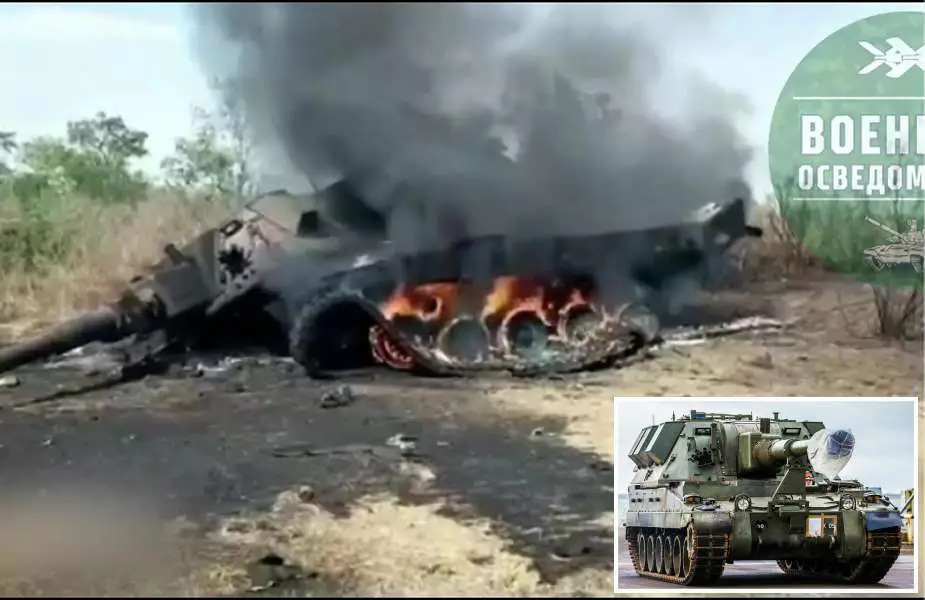- Army
- Conflicts in the world
- Israel - Iran conflict 2025
- Pakistan - India Conflict 2025
- Russia Ukraine War 2022
- Libya conflict day by day
- HAMAS - Israel War 2023
- Operation Serval in Mali French Army
- Sangaris operation Central African Republic
- Sangaris opération militaire République Centreafrique
- Ukraine - Russia conflict
- Syria conflict news
- Defence & Security Industry Technology
- Armies in the world
- Analysis Defense and Security Industry
- Conflicts in the world
- Navy
- Air
Ukrainian AS90 howitzer and Challenger 2 tank destroyed in same sector
According to a video posted on Telegram on September 5, 2023, Ukrainian forces reportedly lost a third UK-supplied AS90 Braveheart 155mm tracked self-propelled howitzers. This incident occurred on the same day and in the same sector as the destruction of the Challenger 2 tank, within the Zaporizhzhia oblast. On January 15, 2023, the Army Recognition editorial team reported that the United Kingdom delivered 30 AS90 Braveheart to Ukraine.
Follow Army Recognition on Google News at this link

Ukrainian forces reportedly lost a third UK-supplied AS90 Braveheart 155mm tracked self-propelled howitzer (Picture source Military Informant/Telegram and UK MoD)
More recently, on June 23, 2023, Army Recognition reported that the AS90 was engaged in its first combat operation by the Ukrainian Armed Forces.
The AS90 is noted for its performance relative to the Ukrainian army's current self-propelled howitzers, the 2S1 Gvozdika and the 2S3 Akatsiya, particularly in terms of range and firepower with its 155mm L31 cannon. It also offers enhanced mobility thanks to its dedicated artillery chassis. However, it's important to note that Soviet-designed systems like the Gvozdika and Akatsiya maintain their own advantages, including reliability, cost-effectiveness, and widespread use in various military forces globally.
The AS90 is a British self-propelled 155mm artillery piece mounted on a tracked chassis vehicle. Its development dates back to the late 1980s, and it remains in active service with the British Army today. Equipped with a 155mm 39 caliber barrel capable of firing various shell types, including high explosive, smoke, and illuminating rounds, the AS-90 is also compatible with the high-precision guided projectile M982 Excalibur.
The AS90's turret houses 48 projectiles and charges, with 31 stored in the turret bustle within four magazine modules, each equipped with a motor for precise projectile positioning. Using standard ammunition and charges, the 39-caliber barrel achieves a range of 24,700 meters. When employing an assisted projectile, the range extends to over 30,000 meters. Additionally, equipping the AS90 with a 52 caliber barrel enhances its area coverage, reaching a maximum range of 30,000 meters with conventional projectiles and 40,000 meters with assisted projectiles.
Powered by a Cummins VTA903T diesel engine, the AS90 exhibits mobility, reaching speeds of up to 55 km/h, and possesses an operational range of 370 km, highlighting its endurance and versatility in the field.
The loss of modern vehicles, including tanks and self-propelled howitzers, is often considered a foreseeable outcome in a counteroffensive due to various factors. Counteroffensives frequently involve heavy combat in contested areas, exposing modern vehicles to enemy fire, including anti-tank missiles, artillery, and advanced weaponry, thereby increasing the likelihood of vehicle losses. Moreover, counteroffensives may require military operations in diverse and challenging environments, such as urban areas, which can be especially hazardous for armored vehicles. Additionally, the prioritization of mobility and speed in counteroffensives can lead to vehicles being deployed into unfamiliar or hostile territory, increasing their exposure to threats.
Counteroffensives also strain logistics and maintenance capabilities, particularly when supply lines are disrupted or repair and resupply units are targeted by the enemy. Opposing forces may possess advanced anti-tank and anti-vehicle weapons, making it challenging to protect modern armored vehicles. These weapons can include advanced guided missiles, rocket-propelled grenades (RPGs), and cyberattacks targeting vehicle systems. Furthermore, the strategy of catching the enemy off-guard in counteroffensives can make modern vehicles susceptible to surprise attacks, elevating the risk of losses.
As conflicts continue, attrition of modern vehicle assets becomes more likely, as they accumulate wear and tear and require maintenance, potentially becoming less reliable, leading to breakdowns or combat losses. Lastly, modern counteroffensives often face a range of threats, from traditional military forces to irregular and insurgent groups, which may employ unconventional tactics and weaponry that challenge even the most advanced vehicles.


























